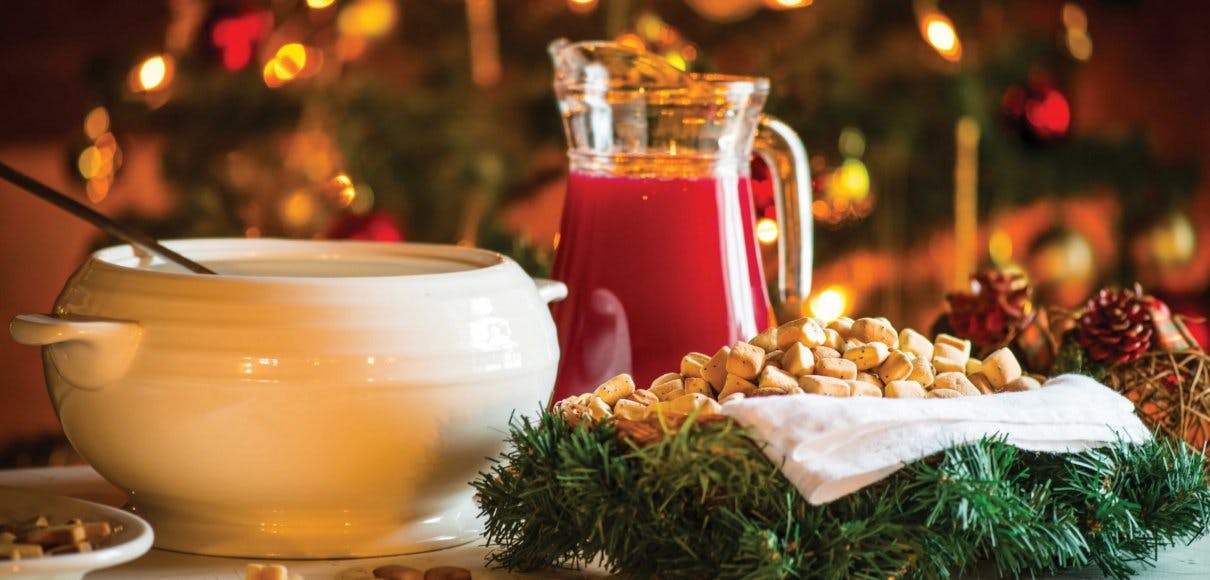Dainius Vaičekonis
Assistant Professor of Piano;
Director of Keyboard Studies
LITHUANIA
IN LITHUANIA, CHRISTMAS EVE is the most important holiday celebration of the year. Many people fast from meat and dairy — some for one week before Christmas; others during the whole season of Advent.
The Christmas Eve table is prepared by scattering a bit of straw on top, as a reminder that Christ was born in a manger, and a clean white tablecloth is spread over the straw. Some families set a place to remember a departed loved one.
As in other countries of the region, the Kūčios (Christmas Eve) meal consists of 12 dishes. The dishes may vary depending on the family, but typical ingredients include beans, carrots, peas, cucumbers, mushrooms, potatoes, and herring. Sweet dishes are avoided until Christmas Day, except kissel (a fruit soup thickened with potato flour) or stewed fruit compote.
One special tradition involves a basket of kalėdaičiai, thin wafers reminiscent of the Eucharist. These unleavened, rectangular wafers feature embossed Christmas scenes. The head of the house breaks and shares the wafers with each family member, and they in turn share the wafers with each other. Leftover wafers are sprinkled on each of the 12 Christmas dishes.
There’s one dish that no Lithuanian Christmas would be complete without: kūčiukai, very small poppy seed biscuits soaked in poppy seed milk.
DAINIUS: Christmas Eve is a deeply meaningful and spiritual time. The whole family gathers to sing, pray, and remember anyone who passed away during the year. At the meal, no one talks about gifts. It’s a wonderful time of reflection, hope for the future, and remembering the past year.
I find these traditions lend themselves to a time of cleansing and purification. When the meal is done — which can take quite a while with 12 dishes — we wait until midnight and attend a Mass service. Then, children open their presents. We laugh about small superstitions people no longer believe but still perform, like drawing straws to predict what kind of year lies ahead. But what I recall most is a lot of expectation about the magic and meaning of that night.
RECIPE:
Kūčiukai (Christmas Biscuits) With Aguonpienis (Poppy Seed Milk)
Servings: 10 to 12
Kūčiukai
1/2 cup warm water
2 tablespoons sugar
1 teaspoon active dry yeast
2 cups all-purpose flour
1 teaspoon table salt
1/4 cup poppy seeds
1 tablespoon cooking oil
Preparation
Dissolve the sugar and yeast into the warm water in a small bowl. Let this stand for a few minutes so that the yeast can activate.In the meantime, sift the flour into a large bowl and add the salt and poppy seeds, mixing well. Add the oil and yeast mixture to the flour mixture and knead together for about 10 minutes until the texture is consistent. Cover and let rise in a warm spot until the dough has doubled in size, at least 1 hour.
Preheat oven to 350 degrees Fahrenheit. Cut dough into four equal parts. Roll each part into long strands about 1/2 inch in diameter. Cut each strand into small cubes and place on a buttered cookie sheet. Bake for 15 to 20 minutes, until golden.
Poppy Seed Milk
1/2 lb. poppy seeds
2 cups boiling water
1/4 teaspoon almond extract
1 tablespoon honey
Preparation
Place the poppy seeds in a bowl or pot and pour the boiling water over the seeds. Let stand for one hour. Pour the undrained poppy seed mixture into a blender and add almond extract and honey. Blend on high for three to four minutes until the mixture turns a whiteish-brown color. Lay several layers of cheesecloth (or use a nut milk bag) into a bowl and pour a portion of the mixture into the cheesecloth. Gather the cheesecloth around the mixture and squeeze tightly until all of the juice or “milk” has been squeezed out. Discard the pulp and repeat the process until all of the milk has been pressed out of the mixture. Refrigerate until serving time.
To serve, place several kūčiukai into a small bowl or mug and pour the poppy seed milk over them. Let the kūčiukai soak before eating.




